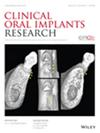Enhancing Osseointegration With LNP-Delivered mRNA-Encoded BMP-2: An Experimental In Vivo Study.
IF 5.3
1区 医学
Q1 DENTISTRY, ORAL SURGERY & MEDICINE
引用次数: 0
Abstract
OBJECTIVE To evaluate the effect of lipid nanoparticle (LNP)-encapsulated N1-methylpseudouridine-modified mRNA encoding BMP-2 (BMP-2 mRNA-LNP) on enhancing osseointegration and bone regeneration around titanium implants in rat femur defects. METHODS A total of 48 rat femurs were examined in this study. BMP-2 mRNA-LNP (5 μg and 15 μg), recombinant human BMP-2 protein (4 μg), or dPBS (control) were randomly injected in a single dose into distal rat femurs (n = 6). Titanium wires were implanted, and bone formation was evaluated at 3 and 6 weeks post treatment using micro-computed tomography, histology, and immunohistochemistry analysis. Data were analyzed using the Kruskal-Wallis test, followed by the Dunn-Bonferroni test and the Wilcoxon signed-rank test with 95% confidence intervals (CIs). p-values < 0.05 were considered statistically significant. RESULTS Micro-computed tomography analysis of bone volume, bone volume fraction, trabecular number, trabecular thickness, and bone-to-implant contact at both time points indicated a trend toward greater bone formation in the mRNA groups compared to the other groups. Significant differences were observed between the 15 μg BMP-2 mRNA-LNP group and the dPBS group at 6 weeks (p < 0.05). The 15 μg BMP-2 mRNA-LNP group also exhibited the most intense positive bone sialoprotein and osteocalcin staining compared to the other groups at 3 weeks and 6 weeks, respectively. Interestingly, histomorphometry at 6 weeks revealed a significantly higher bone area around the implants in both 5 μg and 15 μg BMP-2 mRNA-LNP groups compared to the rhBMP-2 and dPBS groups. CONCLUSION This preclinical study highlights the potential of BMP-2 mRNA-LNP for promoting bone regeneration around dental implants.用lnp传递mrna编码的BMP-2促进骨整合:一项体内实验研究
目的探讨脂质纳米颗粒(LNP)包埋n1 -甲基假尿嘧啶修饰BMP-2 mRNA (BMP-2 mRNA-LNP)对大鼠股骨缺损钛种植体周围骨整合和骨再生的影响。方法对48只大鼠股骨进行检测。将BMP-2 mRNA-LNP (5 μg和15 μg)、重组人BMP-2蛋白(4 μg)或dPBS(对照)随机单剂量注射到大鼠股骨远端(n = 6)。植入钛丝,在治疗后3周和6周通过显微计算机断层扫描、组织学和免疫组织化学分析评估骨形成情况。数据分析采用Kruskal-Wallis检验,随后采用Dunn-Bonferroni检验和95%置信区间(ci)的Wilcoxon符号秩检验。p值< 0.05认为有统计学意义。结果两个时间点的骨体积、骨体积分数、骨小梁数量、骨小梁厚度和骨与种植体接触的显微计算机断层扫描分析显示,mRNA组比其他组有更大的骨形成趋势。6周时,15 μg BMP-2 mRNA-LNP组与dPBS组比较差异有统计学意义(p < 0.05)。15 μg BMP-2 mRNA-LNP组骨涎蛋白和骨钙素染色分别在3周和6周时呈阳性。有趣的是,6周时的组织形态学测量显示,与rhBMP-2和dPBS组相比,5 μg和15 μg BMP-2 mRNA-LNP组种植体周围的骨面积均显著增加。结论本临床前研究表明BMP-2 mRNA-LNP具有促进种植体周围骨再生的潜力。
本文章由计算机程序翻译,如有差异,请以英文原文为准。
求助全文
约1分钟内获得全文
求助全文
来源期刊

Clinical Oral Implants Research
医学-工程:生物医学
CiteScore
7.70
自引率
11.60%
发文量
149
审稿时长
3 months
期刊介绍:
Clinical Oral Implants Research conveys scientific progress in the field of implant dentistry and its related areas to clinicians, teachers and researchers concerned with the application of this information for the benefit of patients in need of oral implants. The journal addresses itself to clinicians, general practitioners, periodontists, oral and maxillofacial surgeons and prosthodontists, as well as to teachers, academicians and scholars involved in the education of professionals and in the scientific promotion of the field of implant dentistry.
 求助内容:
求助内容: 应助结果提醒方式:
应助结果提醒方式:


